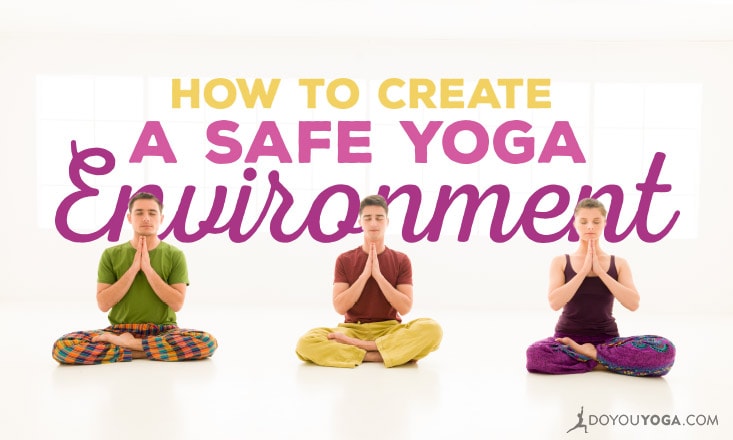When a student comes to the mat, there’s an implied contract they make with you as teacher. Staying safe, honoring one’s self, and practicing ahimsa (non-harming) is of primary importance.
As teachers, however, we cannot be wholly responsible for our students’ safety. We need to teach them to take responsibility for themselves and to build self-awareness. This may mean learning and respecting their limitations, learning to self-adjust, and practicing with less ego and more love for their wellbeing.
You will find yourself saying to your students the phrases “honor your body” and “if appropriate, you might try this option.” Please take time to explain what you actually mean by saying this as it will not be self-evident for most people.
On Effort and Engagement in Yoga
 Credit: Silvia Mordini
Credit: Silvia MordiniI use a technique I call “percenting things out” for folks. I suggest that, once they tune in to themselves through their breath, the students use every pose to assess with mindful awareness the appropriate effort to engage.
I would say, “Let’s really challenge ourselves in a radical way…Why not make only a 50 percent effort, or if you’re really tired, only 30 percent effort? Does every class, every pose require 110 percent effort for the most difficult option? Try less hard poses and take more breaks if that’s what you need today.”
Keeping everyone safe means that we as teachers will encourage our students to rest when necessary and make intelligent choices in maintaining balance between challenging themselves and softening.
This practice is for the individual, and as such, our intuition (inner teacher) will guide us. Our freedom to treat ourselves with respect and kindness is one of life’s greatest gifts!
Let’s teach our students to choose wisely for themselves. Give them space and autonomy to listen to their hearts, and no harm will come to them.
Practical Suggestions for Creating a Loving Yoga Environment
 Credit: Silvia Mordini
Credit: Silvia MordiniTake a moment and remember what it was like to walk into your first yoga class. As you reflect on that experience, how can you as a teacher make an even more loving impression on your students?
Think of these five senses—sight, hearing, smell, love, laughter—and address each one.
- Maintain a clean, visually appealing, and orderly space.
- Creating a welcoming mood, a retreat from the chaos of the day. Play calming music in the waiting area and in the classroom (or studio) to help the student make an easy transition.
- Use aromatherapy and burn candles or incense.
- Help students feel comfortable with their surroundings. This means acquainting them with the setting (where shoes go, where the bathroom is, etc.)
- Use humor to put students at ease. Laugh often, especially at yourself, for making mistakes.
- Make a personal connection with each student every class. Let them know you really see them.
- Proactively introduce yourself to new students.
- Greet every single person hello and goodbye. Remember and use their names.
- Have everyone introduce themselves at the beginning of every class. If time doesn’t permit, have them introduce themselves to one person next to them.
- Arrange class so that newer students are embraced in the middle of the group so they have more experienced students to peek at for guidance.
- Use partner poses to build relationships among students.
- Don’t take yourself too seriously. It’s yoga, not brain surgery.
- Don’t ignore the students you don’t like or find frustrating. They need love too.
- Don’t spend 80 percent of the class with one student—the rest of your students deserve attention too. And more often than not, this one person will feel “picked on.”
- Observe if students are pushing too hard to try to please you or meet your expectations. This brings the focus outside themselves rather than helping students move inward.
- Make the class interactive. Ask if students need clarification in order to avoid confusion. Try using open questions like, “Does that make sense?” or “Do you need more instructions?”
- Be available after class for questions or concerns.
- Leave your bad mood or personal problems outside the class.
- Communicate with confidence through voice, body, and presence to foster a feeling of safety.
- When making suggestions for the refinement of a pose, include how this impacted your practice.
- Use positive reinforcement. Don’t be afraid to tell folks they’re doing great, just be careful not to always bring attention to the student in the most advanced pose as being “good,” because those at the beginning stages will feel like they are “bad,” or “not good enough” in comparison.
- Be careful in what expectations you are silently communicating. Over-efforting results when students get the impression that for you to like them more they have to have advanced poses.
- Share the “yoga tricks” you know. Why not make it easier for them than it was for you?
- Be yourself, not a carbon copy of your favorite teacher. Let your unique, quirky, loving personality shine without apology.
- Do not tell on yourself. If you didn’t do all the poses you had planned, don’t say to your students that you “messed up.” If you forget a pose on the left side that you did on the right, it's ok—during the course of a week, a month, or a lifetime we’ll balance out.
- Lastly, look at yourself through the eyes of your students.
Coming Together
Finally, as a teacher, you cannot energetically take all the responsibility for creating a loving environment. You are just one person.
Enlist your students’ support and encourage them to get to know one another. We are stronger by coming together in yoga (union). Each student in class contributes immensely to the loving environment necessary to help us move deeper into our own hearts during practice.


